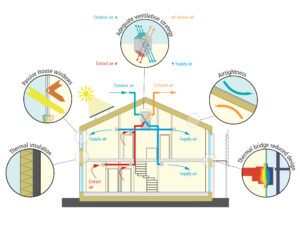What is Passive House?
A Blueprint for Net Zero Living
When we talk about the future of sustainable construction, one phrase rises above the rest: Passive House. But what exactly does it mean, and why is it increasingly seen as the clearest pathway to net zero buildings?
A Global Standard for Energy Efficiency
Passive House (or Passivhaus) is the world’s leading standard for low-energy building. It’s not a style or a brand, but a rigorous performance-based approach to design and construction. At its core, a Passive House is built to use as little energy as possible while providing unmatched comfort, air quality, and resilience.
Buildings that achieve Passive House certification typically cut heating and cooling demand by up to 90% compared to conventional buildings. They do this through a carefully balanced combination of:
- Super-insulation to minimise heat loss.
- Airtight construction that eliminates draughts.
- High-performance windows and doors to lock in comfort.
- Mechanical Ventilation with Heat Recovery (MVHR) to ensure a constant supply of fresh, filtered air.
- Thermal bridge-free detailing to prevent weak spots in the envelope.
The result is a building that’s warm in winter, cool in summer, and consistently healthy for occupants, all while drastically lowering energy bills.
Passive House and Net Zero: Two Sides of the Same Coin
While net zero is the policy and regulatory goal ensuring buildings produce as much renewable energy as they consume, the Passive House standard provides the design method to get there.
Without dramatically reducing demand through a high-performance envelope, true net zero is difficult and costly to achieve. That’s why governments, developers, and forward-thinking architects are embracing Passive House as the most reliable route to meet upcoming zero-emission building regulations.
In short, Passive House is the foundation, net zero is the outcome.

Why Passive House Matters Now
Regulation is tightening: The EU Energy Performance of Buildings Directive requires all new buildings to be zero-emissions in operation by 2030. In Scotland, Passive House (or equivalent) is already mandated for social housing.
Energy costs are rising: Passive House reduces reliance on fossil fuels and shields occupants from price volatility.
Health is in focus: Post-pandemic, people value clean air and thermal comfort more than ever. Passive House delivers both by design.
Finance is shifting: Green mortgages and ESG investment are rewarding energy-efficient projects, making Passive House assets more valuable.
Beyond Homes: Passive House at Every Scale
Though often associated with housing, Passive House applies to every building type. Schools, offices, hospitals, and even high-rise towers. Around the world, developers are proving it works at scale, creating vibrant communities of low-carbon, resilient buildings.
The Future of Building Performance
The buildings we design today will define how we live tomorrow. Passive House shows us that sustainability doesn’t mean compromise; it means smarter, healthier, more future-proof design.
If your goal is to create buildings that meet net zero targets while delivering real comfort and value, Passive House is the benchmark you can trust.
Looking to take the next step? Mosart has trained over 2,500 professionals in Passive House design, helping architects, engineers, and developers deliver projects that truly redefine performance. Explore our Certified Passive House Designer On-Demand course to see how you can be part of the movement.
Passive House FAQs
Is Passive House the same as Net Zero?
Not quite. Net zero refers to buildings that produce as much renewable energy as they consume. Passive House is the design standard that slashes energy demand to ultra-low levels, making net zero achievable practically and cost-effectively. Think of Passive House as the pathway, and net zero as the destination.
What are the benefits for occupants?
Passive Houses deliver consistent thermal comfort, cleaner indoor air through filtered ventilation, and dramatically reduced energy bills. Occupants often report healthier living conditions, with no draughts, cold spots, or mould issues.
Can Passive House work for large buildings?
Yes. Passive House is being applied at every scale, from single-family homes to university campuses, hospitals, and multi-storey developments. The same principles apply: airtightness, insulation, ventilation, and performance verification.
Is Passive House mandatory?
In some places, yes. Scotland has mandated Passive House (or equivalent) for new social housing. The EU’s updated Energy Performance of Buildings Directive requires all new buildings to be zero-emission by 2030, which will effectively mean Passive House-level performance across Europe.
Who is Passive House training for?
Architects, engineers, developers, contractors, and public authorities are all investing in Passive House knowledge. With demand for net-zero-ready skills rising, certified training ensures professionals stay competitive and compliant.